Morocco is famous for its rich culture and lively festivals. Events like the Fes Festival of World Sacred Music and the Marrakech Popular Arts Festival highlight the country’s traditions. These celebrations unite people and foster a sense of community.
The Essaouira Gnaoua World Music Festival and the Rose Festival in Kelaat M’Gouna are just a few of the many festivals. They give visitors a peek into Morocco’s cultural heritage. With traditional music, dance, and food, these festivals are a treat for the senses.
Events like Eid al-Fitr and the Marrakech National Festival of Popular Arts are key to Morocco’s culture. The Fes Festival of World Sacred Music and the Asilah Arts Festival offer a chance to dive into local traditions. It’s a unique way for visitors to experience Moroccan culture.
Key Takeaways
- Morocco is known for its rich cultural heritage and vibrant festivals, including traditional Moroccan celebrations and Moroccan music festivals.
- The Fes Festival of World Sacred Music and the Marrakech Popular Arts Festival are two of the country’s most significant cultural events.
- Traditional Moroccan celebrations, such as the Eid al-Fitr and the Marrakech National Festival of Popular Arts, are an essential part of the country’s cultural identity.
- The Essaouira Gnaoua World Music Festival and the Rose Festival in Kelaat M’Gouna are popular cultural events that attract visitors from around the world.
- Moroccan music festivals, such as the Fes Festival of World Sacred Music, offer a unique experience for visitors, featuring traditional music and dance.
- Cultural events, such as the Marrakech International Film Festival, are an integral part of Morocco’s cultural scene, promoting the country’s rich heritage and traditions.
- Traditional Moroccan celebrations, including the Imilchil Marriage Festival, are a vital part of the country’s cultural identity, showcasing its diverse customs and traditions.
Overview of Moroccan Culture and Traditions
Moroccan culture is a mix of Arabic, Berber, and French. Its location at the crossroads of Africa, Europe, and the Middle East makes it a cultural melting pot. The Taragalte Festival Sahara celebrates nomadic culture, showing off Morocco’s rich heritage.
In Morocco, family and community are key to keeping traditions alive. The country values social bonds and respects elders. This is seen in its many festivals, where people come together to share food, music, and dance. Festivals like the Taragalte Festival Sahara, the Festival of Roses in Kalaat M’Gouna, and the Fez Festival of World Sacred Music are highlights.
- Respect for elders and tradition
- Strong social bonds and family ties
- Rich cultural heritage, including music, dance, and art
- Delicious cuisine, including couscous, tagines, and pastries
- Vibrant festivals and celebrations, such as the Taragalte Festival Sahara
Moroccan culture is a unique blend of influences, shaped by its location and history. By experiencing these traditions, visitors can truly understand Morocco and its people.
The Festival of Eid al-Fitr
Eid al-Fitr is a big celebration in Morocco, ending Ramadan. It’s a time for feasting, giving gifts, and praying together. In Morocco, it’s called Eid es-Seghir, and families buy new clothes for kids.
Families come together for meals like lamb or beef tagine with prunes. They also enjoy couscous and chicken tagine with olives and preserved lemons. Kids get pocket money, and the Eid Al Fitr prayer is held early in the morning.
Eid al-Fitr is special, but it’s also tied to other Moroccan festivals. Like the Moroccan music festival and the Sahara desert festival. These events let visitors try traditional food, learn local customs, and join in community fun.
Significance of Eid al-Fitr
Eid al-Fitr is celebrated on the first day of Shawwal in the Islamic calendar. It changes every year based on the moon. It’s a holiday for Muslims all over the world, ending Ramadan’s fasting.
Common Traditions and Practices
Traditions include the Eid prayer, which is two rakats with different Takbirs. The prayer is followed by a sermon and is done in congregation. It’s held in open areas or mosques.
Festive Foods and Dishes
Traditional breakfasts include Baghrir and msemmen with butter and honey. Lunches feature dishes like lamb or beef tagine with prunes. Families also enjoy couscous and chicken tagine with olives and preserved lemons.
The Festival of Eid al-Adha
Eid al-Adha is a big cultural event in Morocco. It’s a time for families and friends to gather. They celebrate sacrifice, charity, and community.
This festival honors the Prophet Ibrahim’s act of obedience to God. It’s also known as the Festival of Sacrifice.
In the Sahara region, Eid al-Adha brings desert music celebration. Traditional songs and dances fill the air. Families wear traditional clothes, with men in “fouqia” robes.
Prayer gatherings happen in mosques or “musallas.” This strengthens community bonds.
Understanding the Sacrifice Concept
The ritual sacrifice is about sharing meat with others. It promotes unity and generosity. Traditional dishes like couscous and tajine are made with the meat.
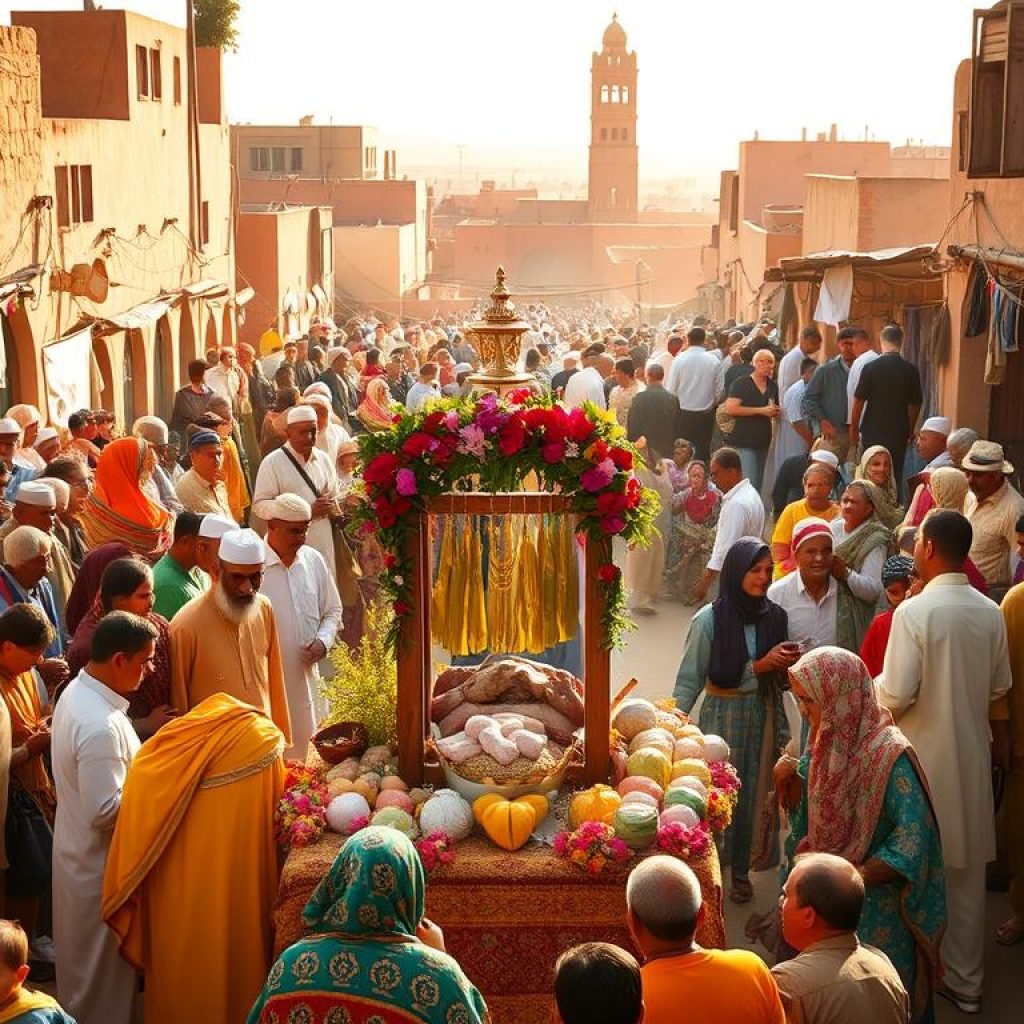
Ritual Practices and Traditions
Key traditions include:
- Preparing Boulfaf and Mrouzia
- Visiting families and friends, sharing meals
- Collecting “Eidiya” (holiday gifts) for children
- Long dinners that last into the night
Community and Charity During Eid
Eid al-Adha brings families and friends together. It’s a time for desert music celebration. The festival promotes unity and generosity in the Sahara region.
Mawlid al-Nabi: The Prophet’s Birthday
Mawlid al-Nabi is a big celebration in Morocco, marking the Prophet Muhammad’s birth. It’s filled with cultural activities and traditions. In some places, a nomadic music festival is held, showing off Moroccan music and culture.
This holiday is not just in Morocco; it’s a national holiday in many Muslim-majority countries. In Turkey, it’s called Mevlid Kandili, with poems recited in mosques and homes. In other areas, a Berber music festival is held during Mawlid, celebrating the Berber culture.
Some common practices during Mawlid include:
- Communal meals, with a focus on sweet treats such as halawiyat, Turkish delight, and maamoul
- Street decorations and food distribution to the public
- Processions with drummers and religious songs
The Berber New Year: Yennayer
Yennayer, the Berber New Year, is a big deal in the Sahara. It starts on January 12th and ends on January 14th. It’s celebrated in places like Algeria, Morocco, Tunisia, Libya, and Egypt.
The Yennayer meal is a big part of the fun. It includes dried legumes like lentils and chickpeas. In Algeria, couscous is a must, often with legumes and meats. Ourkemen, a thick porridge, is also a favorite.
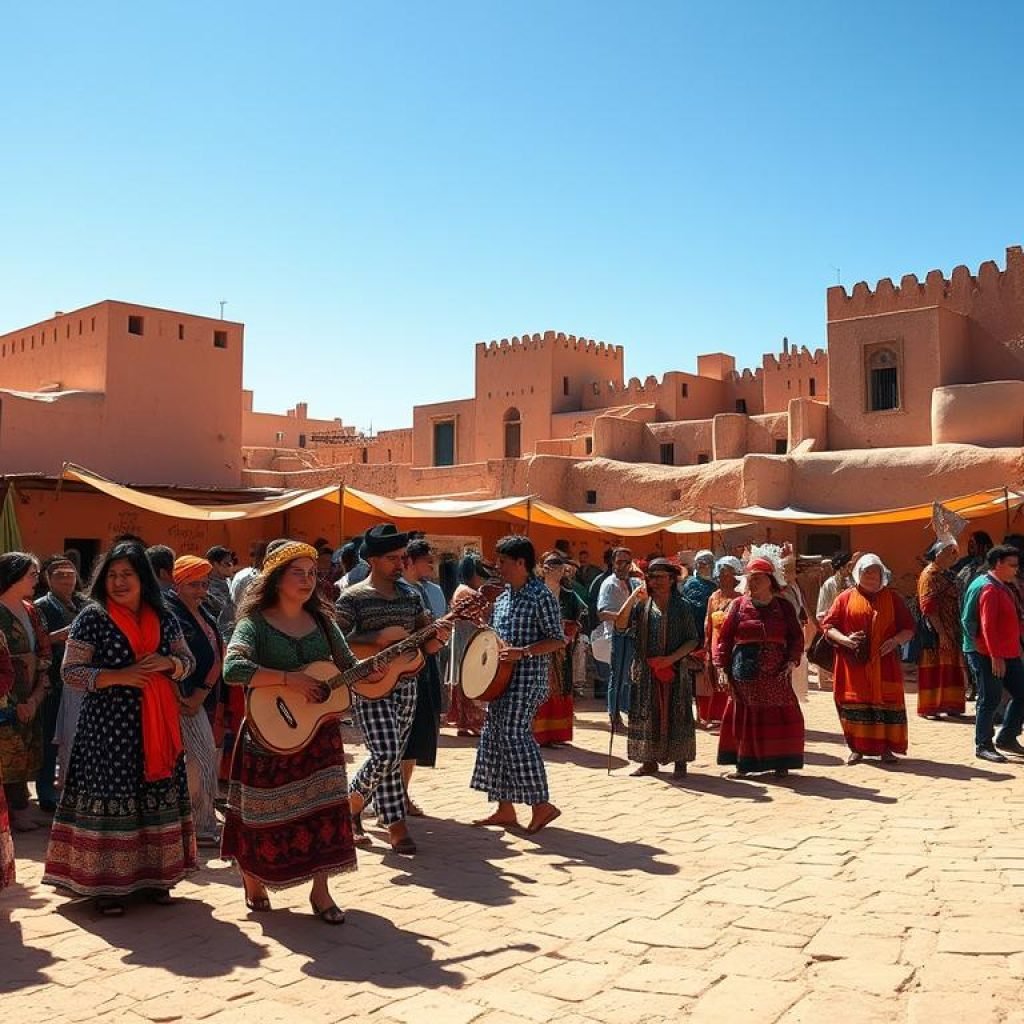
Yennayer is more than just food. It’s a time for first haircuts and weddings. It’s also when kids collect fruits and veggies for future harvests. As a Moroccan music festival, Yennayer celebrates the Berber community’s traditions.
Some traditional Yennayer foods and activities are:
- Trida and chakhchoukha in the Chaoui region of Algeria
- Asfel and berkukes in the Kabyle region of Algeria
- Tagula made of barley with smen and argan oil in the Sous region of southern Morocco
Yennayer is a time for joy, renewal, and coming together. Its importance goes beyond the Berber community, highlighting the Sahara’s rich culture.
The Festival of Roses in Kalaat M’Gouna
The Festival of Roses is a lively event celebrating the rose harvest. It features parades, beauty pageants, and cultural exhibitions. Held in the Valley of the Roses, at the foot of the High Atlas mountains, it draws thousands of people. This includes both Moroccans and tourists from abroad.
The festival takes place in mid-May. It sometimes goes into early June if tour groups ask for it.
The region is famous for its rose cultivation. The festival lets Moroccan merchants show off their handicrafts. You can find tapestries, pottery, and rose-based products. Traditional dishes like tajine and couscous are also available, along with mint tea.
The Festival of Roses highlights the Sahara desert festival and desert music celebration. It’s a unique event that shows the beauty of Morocco.
Some key activities and events include:
- Parade of rose petal floats
- Election of a Rose Queen
- Live music performances, including traditional Berber, Gnawa, and Chaabi music
- Art exhibitions and street parades
- Traditional dancing and the ritual of rose harvesting
The festival boosts the local economy, attracting thousands of visitors. The area is known for rosewater, rose oil, and attar of roses. These products are sold in local markets during the festival.
The Festival of Roses is a must-see for anyone interested in Morocco’s beauty and culture. It’s a great example of a successful desert music celebration and Sahara desert festival.
The festival has been held every year since 1933. It lasts for three days. Visitors can see traditional dancing and the ritual of rose harvesting. There are tours from nearby cities like Marrakech and Casablanca.
The Festival of Roses is a colorful celebration. It showcases the beauty of the rose harvest and Moroccan culture. It’s a great example of a successful Festival of Roses and Sahara desert festival.
The Chellah Festival in Rabat
The Chellah Festival is a celebration of music, art, and culture. It takes place in the Chellah ruins. This Moroccan music festival is a big cultural event in Rabat, Morocco. It’s known for its history and cultural activities.
Artists from Europe and Morocco perform at the festival. They showcase a mix of musical styles. This makes the festival special.
At the Chellah Festival, you can see performances by Markus Stockhausen and Sarab. Hiba Mekkaoui also performs. There’s a musical meeting between Daniel Garcia and Driss El Maloumi.
The festival focuses on peace and cultural exchange. It’s a unique Chellah Festival experience.
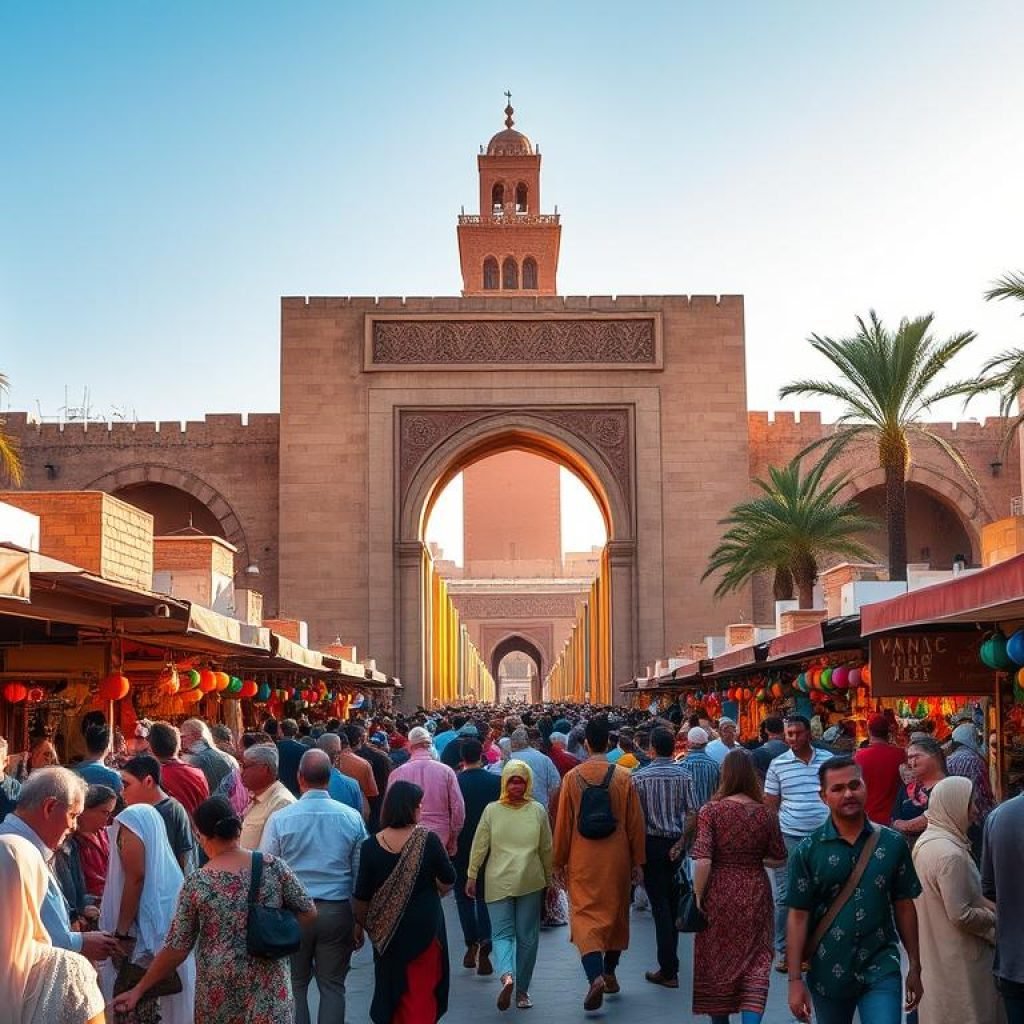
Historical Background of Chellah
The Chellah necropolis was left empty in 1154. It stayed that way until the 14th century. It was built by Abu al-Hassan in 1339.
By 1500, there were 30 Benimerin tombs in the Chellah necropolis.
Cultural Activities During the Festival
The festival has masterclasses with musicians like Climène Zarkan and Aziz Sahmaoui. The Salt group will perform a unique concert. It blends jazz with swing, Latin, ska, and Cajun.
Evening concerts start at 8 PM. This makes the Chellah Festival a top Moroccan music festival and cultural event.
The Festival of the Sahara: Tantan Moussem
The Tantan Moussem is a Sahara desert festival. It celebrates the Sahara region’s cultural heritage. It focuses on nomadic traditions and preserving cultural heritage.
This nomadic music festival has been running for over 60 years. It started in 1963. It includes horse races, camel trading, and cultural events like music and poetry contests.
It’s the biggest gathering of nomadic tribes in northern Africa. More than 30 tribes from southern Morocco and Northwest Africa join. About 800 tents are set up for attendees, made from camel and lamb hair.
The main trading activity is thousands of dromedary camels.
Significance of the Festival
The Tantan Moussem honors Mohamed Laghdaf, a Saharan leader who died in 1960. It was banned in 1979 for security reasons. But, it was brought back in 2004 with UNESCO and Moroccan Ministry of Tourism support.
In 2008, UNESCO added it to the Intangible Cultural Heritage list.
Key Events and Activities
The festival has a “fantasia” where warriors reenact a traditional charge. Nomadic tribes come from Mali, Mauritania, and Niger. It’s now held every December, with thousands of nomadic tribe members attending.
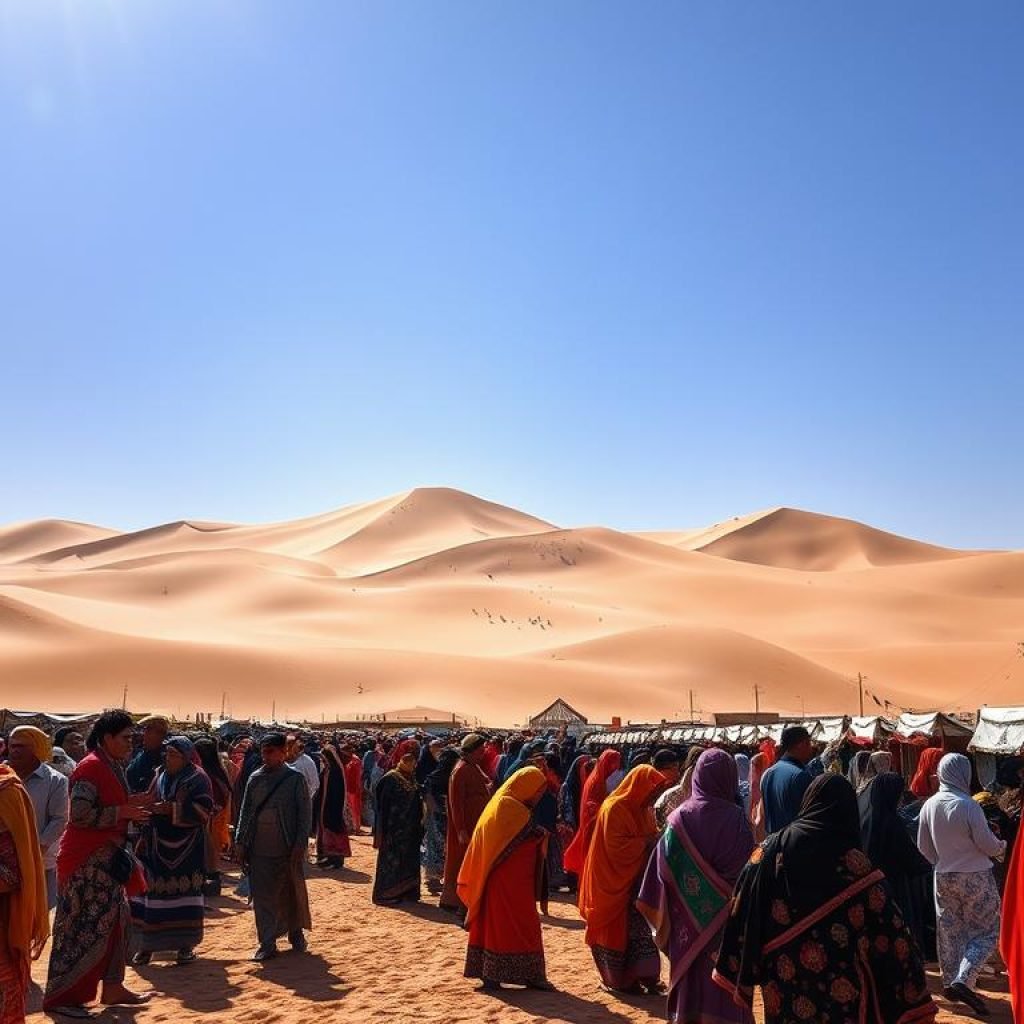
Cultural Heritage and Preservation
The Tantan Moussem is key for preserving Sahara region cultural heritage. It showcases nomadic traditions and cultural expressions. It also offers a chance for tribes to share ideas and practices.
- More than 30 tribes participate in the festival
- Approximately 800 tents are set up during the festival
- The festival features a variety of activities, including horse races and camel trading
The Tantan Moussem is a major event in the Sahara desert festival calendar. Its importance goes beyond the region. It promotes cultural understanding and exchange among different communities.
The Gnaoua World Music Festival
The Gnaoua World Music Festival is a lively celebration in Morocco. It showcases the unique sounds of Gnaoua music. This cultural event Sahara draws visitors from all over, celebrating rich cultural heritage and diverse music.
As a Berber music festival, it emphasizes the need to keep traditional music and culture alive. The festival has been a big part of the Moroccan cultural scene for over 20 years. It brings together local and international artists, fostering cultural exchange and collaboration.
The Gnaoua World Music Festival is more than just music. It’s a celebration of Moroccan culture and traditions.
Overview of Gnaoua Music
Gnaoua music has a long history, dating back to the 16th century. It was recognized by UNESCO in 2019 as part of Morocco’s cultural heritage. This music is a unique mix of African, Arab, and Berber sounds, making it truly captivating.
International Collaboration and Appeal
Every year, the festival welcomes up to 500,000 visitors, making it a major event in Morocco. Artists from Spain, Palestine, the USA, Guadeloupe, and France perform. It’s also teaming up with Berklee College of Music for a residency program, boosting its global appeal.
The festival’s global reach and collaboration make it a special place for cultural exchange and musical creativity. As a cultural event Sahara, it continues to draw visitors worldwide. It showcases Morocco’s rich cultural heritage and the unique sounds of Gnaoua music.
The Moroccan National Day
The Moroccan National Day is a big cultural event that celebrates the country’s freedom and unity. It’s a time for Moroccans to unite and show their national pride. The day is filled with music, dance, and desert music celebration in the Sahara.
This day is special because it brings people from all backgrounds together. Families and friends meet, share food, and enjoy the cultural event Sahara festivities. It’s also a chance to think about Morocco’s history and look forward to its future.
- Traditional music and dance performances
- Desert music celebration in the Sahara region
- Cultural events and exhibitions
- Traditional food festivals
The Moroccan National Day is a big cultural event that celebrates unity, pride, and heritage. It’s a time for Moroccans to unite and enjoy the desert music celebration and other festivities. It also encourages reflection on history and hope for the future.
Local Festivals and Celebrations
Local festivals in Morocco, like the Asilah Arts Festival, are key to keeping traditions alive. They bring people together and celebrate the country’s rich culture. You’ll see traditional music, dance, and art.
The Asilah Arts Festival is a great example. It shows how important community is in these celebrations. You can enjoy music, see art, and learn about traditional crafts.
Other festivals in Morocco include the Moroccan music festival and the Sahara desert festival. The music festival celebrates Morocco’s music diversity. The Sahara desert festival highlights the Sahara region’s unique culture.
These festivals help the local economy by attracting tourists and locals. They give artists, musicians, and artisans a chance to share their talents.
Some key features of these festivals include:
- Traditional music and dance performances
- Art exhibitions and crafts
- Cultural activities and workshops
- Community engagement and participation
In summary, local festivals and celebrations are vital to Moroccan culture. They offer a peek into the country’s heritage and traditions. By attending, visitors can feel the Moroccan warmth and support local communities.
Conclusion: The Role of Celebrations in Moroccan Identity
Celebrations are key to Moroccan culture, keeping its heritage alive and building a strong identity. Events like the Berber New Year of Yennayer and Sahara festivals show the nation’s strength and tradition. These celebrations are a testament to Moroccan traditions’ resilience and adaptability.
The Amazigh community, with over 8 million people, guards Moroccan culture. In 2011, Tamazight became an official language, a big step for their culture. Yet, French still dominates many public areas, limiting Tamazight’s use.
The future asks for a balance between modernity and tradition in Moroccan society. The RNI party’s win brings hope for more Amazigh heritage and celebration recognition. This could lead to a more inclusive cultural preservation.
As Moroccans celebrate their diverse culture, the world gets to see a nation’s spirit. This spirit blends the old with the new, creating a unique identity that reaches far beyond its borders.


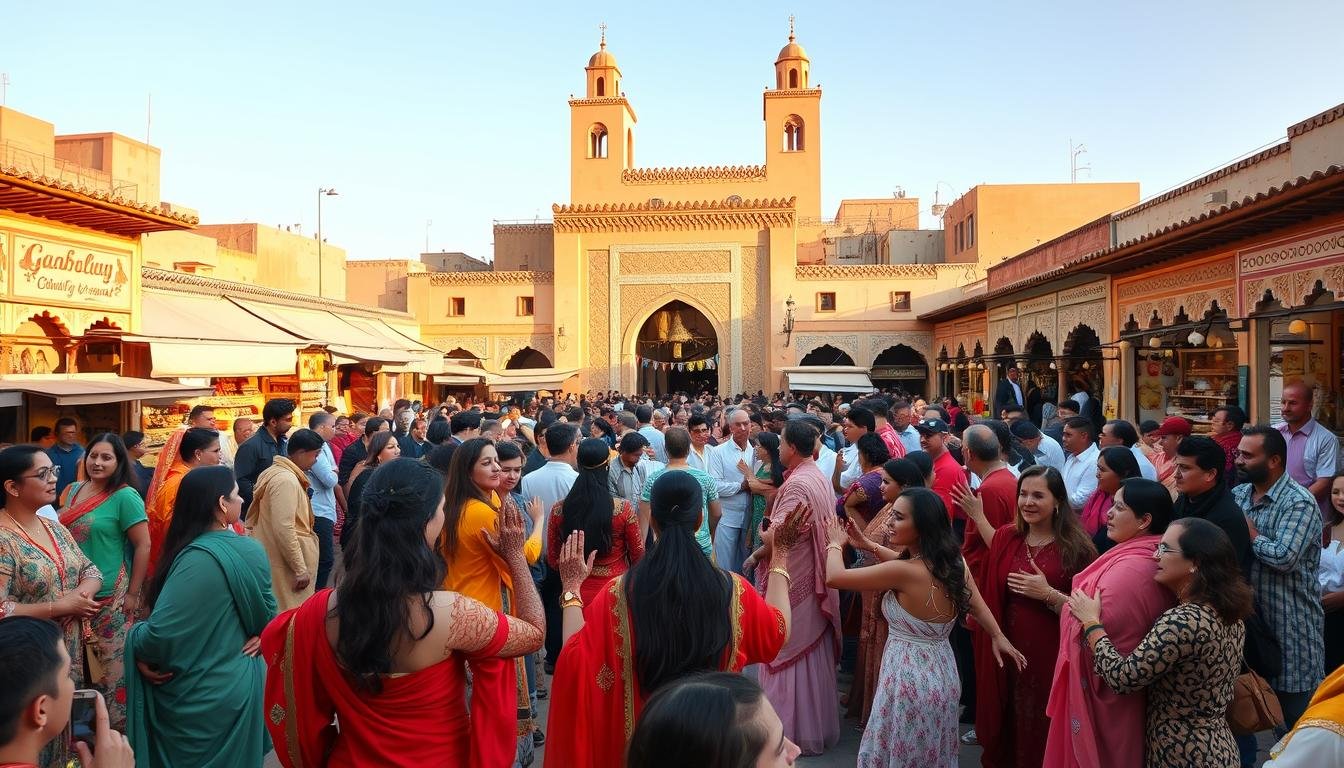

Comment (0)